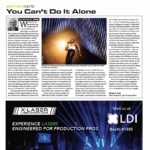I saw two shows last month that had absolutely no video components. It was odd, having to focus on the performers themselves with nothing other than a lovely set to distract you. Okay, one was The Grinch, a play performed quite professionally at the Children’s Theater of Minneapolis. And the other was a punk rock band I saw thrashing in a club. They were good shows… but then I saw Fleetwood Mac last night, and it was a spectacle to behold. It all came back to me — why I love my pixels. I like them small, big, spread out or even on curved surfaces. They just make me happy.
Using Video Effectively
The Fleetwood Mac show (the same tour featured on the Jan. 2015 PLSN cover) started with no video at all for the first few songs. Sexily-lit fabric in front of the rear video wall was used instead of video in a variety of lighting scenarios. Then, in time, some small bits of video showed up on the back wall. Then it grew, eventually filling more of the gigantic back wall of LED panels. Finally, all of the video components came on and started to move. And I started to drool.
The first time I saw low-res video, I thought to myself, “What a waste.” I was in London’s Hyde Park, and I had walked down to see my friend Scott Holthaus, who was there lighting the Red Hot Chili Peppers. The video elements on his stage must have stretched 200 feet wide. He was going on to me about why he had all these different resolution screens and video devices. Some were 9mm others were about 200mm. I was standing in a field, mid-afternoon, not understanding much of the technical jargon he was telling me, thinking this is going to be strange. Eventually, the sun went down, and I saw what he was doing. I realized then that this was the direction the biz was going, like it or not.
But I don’t always like it. Sometimes, I like a show best when the video stops. A little more than 20 years ago, U2 changed the world when they did the “Zoo TV” tour. They had scattered video projection and cool elements that, to this day, added up to one of the best shows I have ever seen. Then, in 1997, they played the PopMart tour in front of a 165-foot-wide video wall. It totally sucked for me. I could not find the performer at times, dwarfed by pixels. There was content being shown that had nothing to do with whatever song was being played, and I just thought it was all one big distraction. I remember watching one song that just depicted an animated shopping cart being pushed through a supermarket. I guess this is what they were referring to as Pop Art. I was watching the show for about an hour when, all of a sudden, the video stopped, and I could see some stage lighting. It looked good, and I thought maybe the show was going in another direction. But that was short-lived.
New Options, and Choices
Shows have come a long way since then, especially with various shaped video surfaces and the advent of pixel-mapping everything. It took me years to embrace video as a useful video effect. Now, I spend time wondering what pixel size I want different elements in. Do I want to just use high res LED or projection up stage? Do I add a bunch of Upstaging Sabers (see Road Test, page 52) to a set design, or am I thinking that LED tape will be more cost efficient? Do I get enough bang for my buck adding video to the front of each set riser, or is that going to distract from the whole show? Well, maybe if I have a product that is, like, 50mm, it will look better on those risers than some high-def product.
This month, I got to see some amazing new LED products on display from all the manufacturers while researching this month’s Buyers Guide (page 30). The 2mm high-def stuff I saw from one company, and the curving flexibility of another, had me marvel at technology (See the “Product Spotlight” on PixelFlex’s FLEXcurve, page 51). Just when I thought Roe Visual had the coolest product with last year’s hybrid screen, they now release a glare proof model of their high-def tiles. Finally, someone has built a successor to the Versa Tube, which can come in different pixel pitches with a removable cover. And I think we are just dabbling at the possibilities of what we are doing right now. There is no end in sight or way to avoid the use of LED in most any show. So we might as well embrace it.


